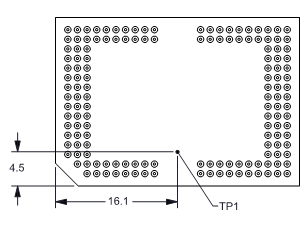JAJSFP0F March 2016 – May 2019 DLP5530-Q1
PRODUCTION DATA.
- 1 特長
- 2 アプリケーション
- 3 概要
- 4 改訂履歴
- 5 Pin Configuration and Functions
-
6 Specifications
- 6.1 Absolute Maximum Ratings
- 6.2 Storage Conditions
- 6.3 ESD Ratings
- 6.4 Recommended Operating Conditions
- 6.5 Thermal Information
- 6.6 Electrical Characteristics
- 6.7 Timing Requirements
- 6.8 Switching Characteristics
- 6.9 System Mounting Interface Loads
- 6.10 Physical Characteristics of the Micromirror Array
- 6.11 Micromirror Array Optical Characteristics
- 6.12 Window Characteristics
- 6.13 Chipset Component Usage Specification
- 7 Detailed Description
- 8 Application and Implementation
- 9 Power Supply Recommendations
- 10Layout
- 11デバイスおよびドキュメントのサポート
- 12メカニカル、パッケージ、および注文情報
パッケージ・オプション
デバイスごとのパッケージ図は、PDF版データシートをご参照ください。
メカニカル・データ(パッケージ|ピン)
- FYK|149
サーマルパッド・メカニカル・データ
発注情報
7.6 Micromirror Array Temperature Calculation
 Figure 19. DMD Thermal Test Points
Figure 19. DMD Thermal Test Points The active array temperature can be computed analytically from measurement points on the outside of the package, the package thermal resistance, the electrical power, and the illumination heat load.
Relationship between array temperature and the reference ceramic temperature (thermocouple location TP1 in Figure 19) is provided by the following equations:
where
- TARRAY = computed DMD array temperature (°C)
- TCERAMIC = measured ceramic temperature, TP1 location in Figure 19 (°C)
- RARRAY–TO–CERAMIC = DMD package thermal resistance from array to thermal test point TP1 (°C/W), see Thermal Information
- QARRAY = total power, electrical plus absorbed, on the DMD array (W)
- QELECTRICAL = nominal electrical power dissipation by the DMD (W)
- QILLUMINATION = (CL2W × SL)
- CL2W = conversion constant for screen lumens to power on the DMD (W/lm)
- SL = measured screen lumens (lm)
Electrical power dissipation of the DMD is variable and depends on the voltages, data rates, and operating frequencies.
Absorbed power from the illumination source is variable and depends on the operating state of the mirrors and the intensity of the light source.
Equations shown above are valid for a 1–chip DMD system with a total projection efficiency from DMD to the screen of 87%.
The constant CL2W is based on the DMD array characteristics. It assumes a spectral efficiency of 300 lm/W for the projected light and illumination distribution of 83.7% on the active array, and 16.3% on the array border.
The following is a sample calculation for a typical projection application:
- SL = 50 lm
- CL2W = 0.00293 W/lm
- QELECTRICAL = 0.4 W (This number does not represent an actual DMD electrical power; for illustration purposes only)
- RARRAY–TO–CERAMIC = 1.1°C/W
- TCERAMIC = 55°C
- QARRAY = 0.4 W + (0.00293 W/lm × 50 lm) = 0.5465 W
- TARRAY = 55°C + (0.5465 W × 1.1°C/W) = 55.6°C